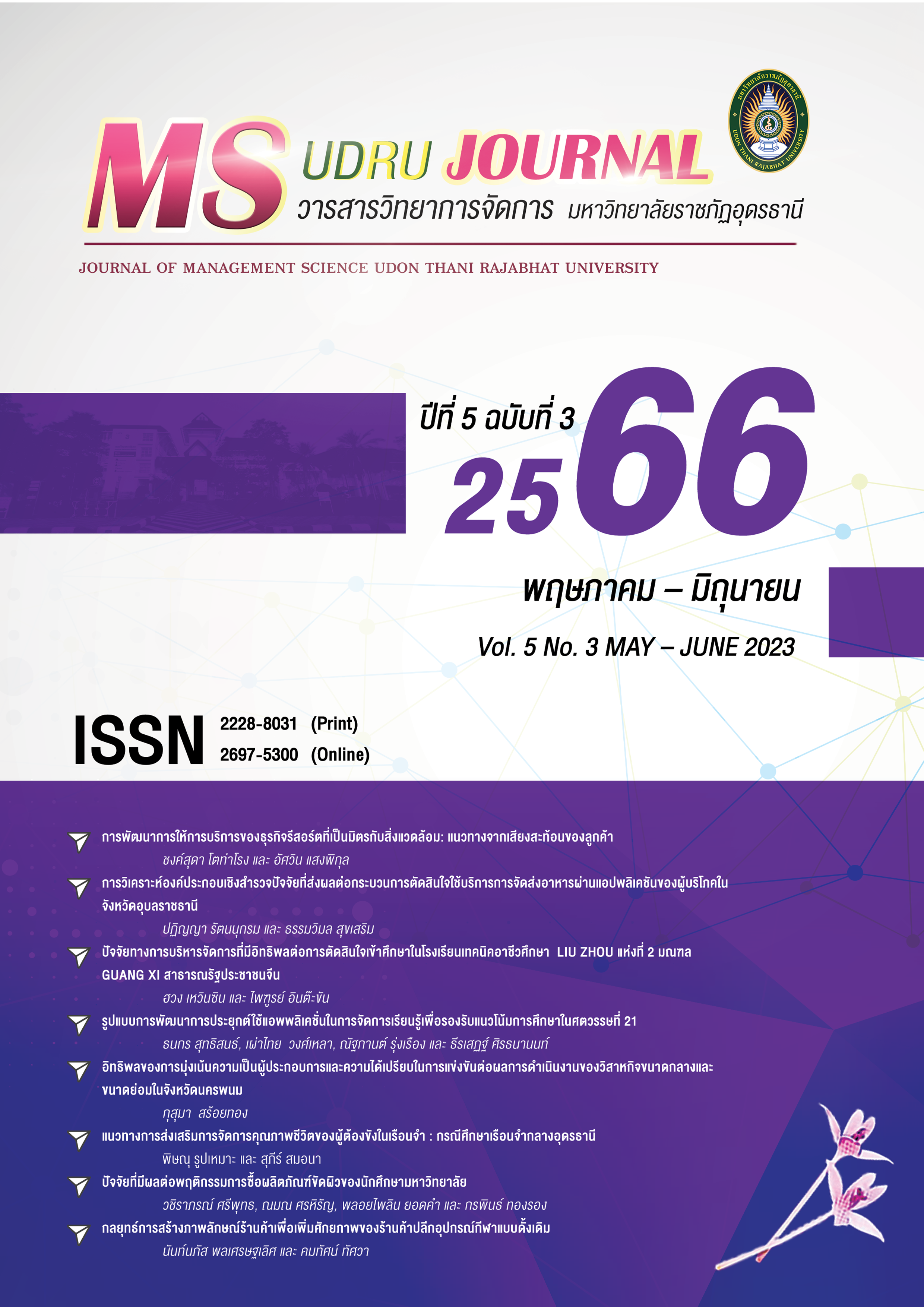อิทธิพลของการมุ่งเน้นความเป็นผู้ประกอบการและความได้เปรียบในการแข่งขันต่อผลการดำเนินงานของวิสาหกิจขนาดกลางและขนาดย่อมในจังหวัดนครพนม
Main Article Content
บทคัดย่อ
การวิจัยครั้งนี้มีวัตถุประสงค์ 1) เพื่อศึกษาการมุ่งเน้นการเป็นผู้ประกอบการที่ส่งผลต่อผลการดำเนินงานของวิสาหกิจขนาดกลางและขนาดย่อม (SMEs) 2) เพื่อศึกษาการมุ่งเน้นความเป็นผู้ประกอบการที่ส่งผลต่อความได้เปรียบทางการแข่งขันของวิสาหกิจขนาดกลางและขนาดย่อม (SMEs) และ 3) เพื่อศึกษาความได้เปรียบทางการแข่งขันที่ส่งผลต่อผลประกอบการของวิสาหกิจขนาดกลางและขนาดย่อม (SMEs) การวิจัยนี้เก็บข้อมูลด้วยแบบสอบถามจากผู้ประกอบการวิสาหกิจขนาดกลางและขนาดย่อมในจังหวัดนครพนม จำนวน 155 คน โดยใช้การวิเคราะห์การสร้างโมเดลสมการโครงสร้าง(Structural Equation Modeling: SEM) ผลการวิจัยพบว่าการมุ่งเน้นความเป็นผู้ประการเพียงอย่างเดียวไม่สามารถส่งผลต่อผลการดำเนินงานได้ ทั้งนี้ผู้ประกอบการจำเป็นต้องพึ่งพาความได้เปรียบในการแข่งขันเป็นตัวกลางที่สำคัญต่อผลการดำเนินงานของวิสาหกิจขนาดกลางและขนาดย่อม ดังนั้นเพื่อให้วิสาหกิจขนาดกลางและขนาดย่อมมีผลการดำเนินงานที่ดี ผู้ประกอบการควรให้ความสำคัญกับความได้เปรียบทางการแข่งขันเพื่อให้ทันต่อการเปลี่ยนแปลงและการแข่งขันที่รุนแรงขึ้น
Article Details

อนุญาตภายใต้เงื่อนไข Creative Commons Attribution-NonCommercial-NoDerivatives 4.0 International License.
บทความที่ได้รับการตีพิมพ์เป็นลิขสิทธิ์ของคณะวิทยาการจัดการ มหาวิทยาลัยราชภัฏอุดรธานี
ข้อความที่ปรากฏในบทความแต่ละเรื่องในวารสารวิชาการเล่มนี้
ไม่ใช่ความคิดเห็นและความรับผิดชอบของผู้จัดทำ บรรณาธิการ กองบรรณาธิการ และคณะวิทยาการจัดการ มหาวิทยาลัยราชภัฏอุดรธานี ความรับผิดชอบด้านเนื้อหาและการตรวจร่างบทความแต่ละเรื่องเป็นความคิดเห็นของผู้เขียนบทความแต่ละท่าน
เอกสารอ้างอิง
กรมพัฒนาธุรกิจการค้า. (2564). ข้อมูลนิติบุคคลรายจังหวัด. สืบค้นเมื่อ 21 เมษายน 2564, จาก https://www.dbd.go.th/more_news.php?cid=1459.
สำนักงานส่งเสริมวิสาหกิจขนาดกลางและขนาดย่อม (สสว.), 2562. SMEs กับการเข้าสู่ “ประชาคมอาเซียน” หรือ ASEAN Community. สืบค้นเมื่อ 20 พฤษภาคม 2563 จาก https://www.sme.go.th/upload/mod_download/Chapter6-20171024122349.pdf.
สุรินทร์ พิทักษ์สิกุล, สุมาลี สว่าง และ กฤษดา เชียรวัฒนสุข. (2562). รูปแบบความสำเร็จเพื่อส่งเสริมวิสาหกิจขนาดกลางและขนาดย่อม (SMEs) ในกลุ่มจังหวัดภาคเหนือของประเทศไทย.วารสารดุษฎีบัณฑิตทางสังคมศาสตร์, 9(1), 15–29.
สุวิมล ติรกานันท์. (2551). การสร้างเครื่องมือวัดตัวแปรในการวิจัยทางสังคมศาสตร์: แนวทางสู่การปฏิบัติ. กรุงเทพฯ : จุฬาลงกรณ์มหาวิทยาลัย.
วรายุ ศิรินนท์ และ ระบิล พ้นภัย. (2563). การมุ่งเน้นความเป็นผู้ประกอบการและความได้เปรียบทางการแข่งขันที่ส่งผลต่อผลการดำเนินงานของธุรกิจขนาดกลางและขนาดย่อมอุตสาหกรรมอาหารในกลุ่มจังหวัดภาคตะวันออกเฉียงเหนือตอนล่าง. วารสารชุมชนวิจัย มหาวิทยาลัย ราชภัฏนครราชสีมา, 14(1), 242-252.
Aaker, D. A., Kumar, V., & Day, G. S. (2001). Marketing Research, John Wiley&Sons. Inc. New York.
Anderson, B. S., Kreiser, P. M., Kuratko, D. F., Hornsby, J. S., & Eshima, Y. (2015). Reconceptualizing entrepreneurial orientation. Strategic management Journal, 36(10), 1579-1596.
Covin, J. G., & Wales, W. J. (2019). Crafting high-impact entrepreneurial orientation research: Some suggested guidelines. Entrepreneurship theory and practice, 43(1), 3-18.
Dess, G. G., McNamara, G., Eisner, A. B., Lee, S. H. (2019). Strategic management: Text & cases. Ninth edition. New York: McGraw-Hill Education.
Fornell, C., & Larcker, D. F. (1981). Structural equation models with unobservable variables and measurement error: Algebra and statistics.
George, D., & Mallery, M. (2010). SPSS for Windows Step by Step: A Simple Guide and Reference, 17.0 update (10th ed.) Boston: Pearson.
Hair, J., Bush, R., & Ortinau, D. (2006). Marketing Research within a changing environment (Revised international edition). New York: McGraw-Hill.
Hair, J. F. (2009). Multivariate data analysis.
Hammerschmidt, J., Eggers, F., Kraus, S., Jones, P., & Filser, M. (2020). Entrepreneurial orientation in sports entrepreneurship-a mixed methods analysis of professional soccer clubs in the German-speaking countries. International entrepreneurship and management journal, 16(3), 839-857.
Hossain, M. A., Akter, S., & Yanamandram, V. (2021). Why doesn't our value creation payoff: Unpacking customer analytics-driven value creation capability to sustain competitive advantage. Journal of Business Research, 131, 287-296.
Jiang, X., Liu, H., Fey, C., & Jiang, F. (2018). Entrepreneurial orientation, network resource acquisition, and firm performance: A network approach. Journal of Business Research, 87, 46-57.
Kaplan, R. S., & Norton, D. P. (1996). Using the balanced scorecard as a strategic management system.
Krejcie, R. V., & Morgan, D. W. (1970). Sample size recommendations. Educational and Psychological Measurement, 30, 608.
Li, S., Ragu-Nathan, B., Ragu-Nathan, T. S., & Rao, S. S. (2006). The impact of supply chain management practices on competitive advantage and organizational performance. Omega, 34(2), 107-124.
Lumpkin, G. T., & Dess, G. G. (2001). Linking two dimensions of entrepreneurial orientation to firm performance: The moderating role of environment and industry life cycle. Journal of business venturing, 16(5), 429-451.
McKenny, A. F., Aguinis, H., Short, J. C., & Anglin, A. H. (2018). What doesn’t get measured does exist: Improving the accuracy of computer-aided text analysis. Journal of Management, 44(7), 2909-2933.
MacKinnon, D. P., Fairchild, A. J., & Fritz, M. S. (2007). Mediation analysis. Annual review of psychology, 58, 593.
Mehrabi, H., Coviello, N., & Ranaweera, C. (2019). Ambidextrous marketing capabilities and performance: How and when entrepreneurial orientation makes a difference. Industrial Marketing Management, 77, 129-142.
Miller, A., & Dess, G. G. (1996). Strategic Management (2nd ed.). New York : McGraw-Hill.
Mostafiz, M. I., Hughes, M., & Sambasivan, M. (2021). Entrepreneurial orientation, competitive advantage and strategic knowledge management capability in Malaysian family firms. Journal of Knowledge Management.
Nunnally, J., & Bernstein, J. C. (1994). Psychometric Theory, 3rd Edition. New York: McGraw-Hill.
Porter, M. F. (1980). An algorithm for suffix stripping. Program.
Wales, W. J. (2016). Entrepreneurial orientation: A review and synthesis of promising research directions. International Small Business Journal, 34(1), 3-15.
Wales, W. J., Covin, J. G., & Monsen, E. (2020). Entrepreneurial orientation: The necessity of a multilevel conceptualization. Strategic Entrepreneurship Journal, 14(4), 639-660.
Wang, X., Dass, M., Arnett, D. B., & Yu, X. (2020). Understanding firms’ relative strategic emphases: An entrepreneurial orientation explanation. Industrial Marketing Management, 84, 151-164.


